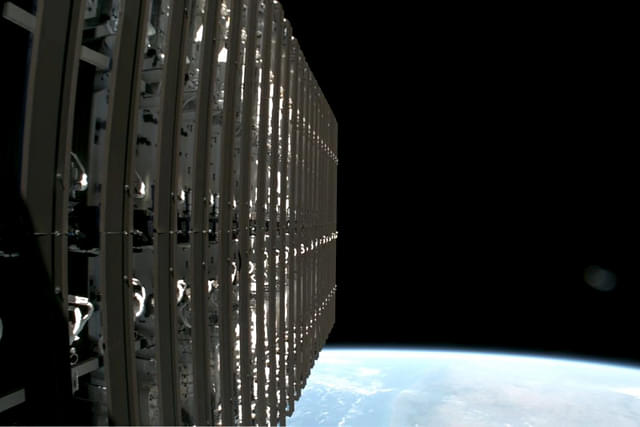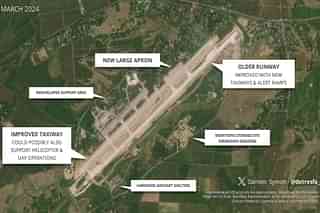Technology
Faster Space WiFi Could Soon Become A Reality, Thanks To Musk’s Starlink Network
Karan Kamble
Apr 13, 2024, 12:08 PM | Updated 12:08 PM IST
Save & read from anywhere!
Bookmark stories for easy access on any device or the Swarajya app.

Faster space WiFi could soon be a reality, thanks to SpaceX's laser-powered Starlink network.
Ever since humans visited the Moon across nine missions from 1968 to 1972, they have only gone as far as the space stations — Skylab, Mir, International Space Station (ISS), and Tiangong.
The most popular of these space pit stops (Skylab and Mir are no more), the ISS has been inhabited continuously since 2000. The astronauts who have hopped on the orbiting spacecraft during these 23+ years have used the internet for both work and play, initially with ground support and later, since 2010, with personal access on board.
The ISS generates a wealth of data around human space flight, space and Earth science research, and technological demonstrations. This data needs to be transmitted to researchers here on Earth so that it can be interpreted or understood and the analysis shared back to the space station as part of a natural feedback loop.
Naturally, astronauts in space and researchers on the ground would love to have high data transfer rates. Although the ISS does a decent job of providing internet access, faster space WiFi is in the offing with SpaceX’s laser-powered Starlink network.
How Astronauts Get WiFi
The ISS crew connects to the internet through a communication system that works in this way:
The space station is equipped with antennas and communication systems necessary to 'converse' with Earth. The conversations occur through radio signals. These signals travel through a network of satellites called Tracking and Data Relay Satellites (TDRS) and special antennas on the ground known as the Space Network.
The TDRS are positioned high above Earth, at various points on an orbit of approximately 36,000 kilometres (km). They pick up signals from the space station. Once the TDRS catches the signals, the satellite network beams them down to Earth using landlines.
These signals then go to various centres of the National Aeronautics and Space Administration (NASA), which are all connected to the internet. Then, computers turn the received signals back into readable data for scientists. This process unfolds in reverse when data transmission occurs from Earth to the space station.
Inside the ISS, a local area network (LAN) connects various computers, communication devices, and the ISS’ own servers. WiFi access points installed throughout the space station provide wireless internet connectivity for use on laptops, tablets, or any other devices that astronauts might use.
However, unlike here on Earth, the crew in space has to make-do with limited and highly secure bandwidth due to the extraordinary nature of the living environment.
The entire communication cycle involving the space and ground stations takes less than a second, enabling astronauts and scientists to chat and send data almost instantly.
Not as good as here at home, but not too bad either.
Data transfer between the ISS and Earth occurs at 600 megabit-per-second (Mbps) currently, after NASA doubled the rate in 2019 through communication infrastructure upgrades. Even faster data transmission will enable new scientific experiments and technology demonstrations, especially those dealing in higher resolution or more detailed data, to be conducted in space.
Not to forget, China also has a space station in orbit called the Tiangong space station. The taikonauts on board get internet access in much the same way as astronauts on the ISS do — through a network of data relay satellites in geostationary orbit.
Faster WiFi With Starlink
Earlier this week, space technology company Vast said that their planned space station Haven-1, set to launch in August 2025 to become the world’s first commercial space station, would tap into SpaceX’s Starlink for high-speed internet in space.
According to Vast’s chief executive officer, Max Haot, Starlink is “the only option” for “high-speed, low-latency, continuous internet connectivity on a space station in orbit in 2025.”
The internet speeds will be higher than ever before in space with Starlink — on the order of gigabit-per-second (Gbps).
The Starlink fleet of satellites, numbering in the thousands, orbits at an altitude of about 550 km from the Earth’s surface. The TDRS network of satellites, upon which the ISS relies, orbits the planet at a significantly higher altitude of about 36,000 km. Due to the significantly smaller distances separating the astronauts, Starlink satellites, and ground stations, the journey time for data — called latency or ping time — is correspondingly lesser in Starlink’s case.
Higher latency is associated with lag, buffering, and slower response times. According to SpaceX, the latency in Starlink’s case is around 25 milliseconds (ms), as compared to around 600 ms in the case of geostationary satellites perched higher up.
Furthermore, the Starlink network will provide faster internet access in space through the use of a laser communication system. Laser communications, or more generally optical communications, offer a much higher bandwidth than the current standard of radio frequency communication. According to NASA, one can expect bandwidth increases of 10 to 100 times with the use of lasers, besides lower size, weight, and power requirements. (NASA is also experimenting with laser communications.)
Since laser beams are more focused and directional, they allow for more efficient data transfer and reduced interference. Additionally, laser communication is more secure than radio frequency communication, and laser transmission between satellites and space stations can help cut dependency on ground stations.
It came to light in January this year that the Starlink laser system was delivering over 42 petabytes (42 million gigabytes) of data for customers per day across more than 9,000 lasers. The lasers can apparently sustain a 100 Gbps connection per link.
The Haven-1 is set to fly in the Dragon spacecraft launched by the Falcon 9 rocket no earlier than August 2025. It will carry a Starlink laser terminal on board, just as other Starlink satellites do to form a laser mesh of communication among each other.
The crew on Haven-1 will then be able to connect their personal devices via Wi-Fi to the Starlink laser internet network.
Save & read from anywhere!
Bookmark stories for easy access on any device or the Swarajya app.
Karan Kamble writes on science and technology. He occasionally wears the hat of a video anchor for Swarajya's online video programmes.
Introducing ElectionsHQ + 50 Ground Reports Project
The 2024 elections might seem easy to guess, but there are some important questions that shouldn't be missed.
Do freebies still sway voters? Do people prioritise infrastructure when voting? How will Punjab vote?
The answers to these questions provide great insights into where we, as a country, are headed in the years to come.
Swarajya is starting a project with an aim to do 50 solid ground stories and a smart commentary service on WhatsApp, a one-of-a-kind. We'd love your support during this election season.
Click below to contribute.





